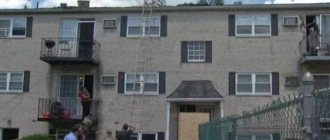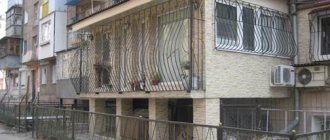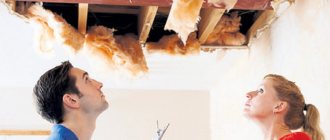Repair and decoration
04/23/2018 Anastasia Prozheva
In most apartment buildings, balconies are in poor technical condition. Most residential buildings are in poor condition; in order to avoid destruction of the building and prevent human casualties, it is necessary to promptly repair and restore damaged areas. The balconies in an apartment building are especially in poor condition, putting at risk not only the residents of the apartment itself, but also people passing nearby.
Balcony and repairs: at whose expense is it carried out?
The question of who should repair balconies in an apartment building does not have a clear answer; in some articles the housing and communal services are indicated, in others - the residents of the building or the HOA.
Load-bearing structures are repaired by housing and communal services, these include:
- Walls of a residential building;
- Foundation;
- Overlap;
- Enclosing columns and structures.
Properly carried out repair work significantly extends the life of the balcony and avoids human casualties.
Unfortunately, today the issue of repairing balconies raises a lot of controversy.
Namely:
- Strengthening the frame of a reinforced concrete slab will make it possible to turn a loggia into a small place for relaxation;
- Properly done waterproofing work will prevent the accumulation of moisture, keeping the frame and concrete dry and strong;
- Installing double-glazed windows will make the balcony warm; you can place flowers in it, creating a winter garden, and relax on a rainy day, reading or doing handicrafts.
Based on the housing code, which specifies that common places are those used by several families, the balcony is private property, so the owners must repair it in an apartment building.
Rules for maintaining common property
The owner of the privatized property and the housing sector have their own areas of responsibility:
- The homeowners association or management company must monitor the condition of the load-bearing balcony slab, doors and windows of the entrance group, as well as railings (if the balcony is intended for general use).
- Utilities must ensure safe operation and necessary repairs of these structures.
- Apartment owners control such parts of the balcony as the roof and canopy, external glazing and enclosing railings, as well as doors and window group.
It is worth noting that if the balcony structure is located on the top floor, then the canopy and roof are the property of the HOA . In this case, if any of these structures leak, then repairs are carried out by utility services.
If the balcony slab is found to be in poor condition, then the repairs must be carried out by the management company.
ATTENTION! In case of refusal to provide such a service for any reason, and the destructive process of the balcony slab is dangerous, the apartment owner can carry out a major overhaul of the balcony on his own. Then file a claim in court to recover the personal expenses incurred.
Who should repair a balcony in a privatized apartment
Even if an apartment with an emergency balcony is privatized, repairs to the load-bearing slab and wall of the house must be carried out by the housing and communal services. If the owner of the apartment is engaged in such repair work and buys materials at his own expense, then it is necessary to keep receipts and receipts, this will be direct evidence of the money spent.
The owner of a privatized apartment is assigned certain duties that he must comply with:
Balcony repairs in a privatized apartment should be carried out by the management company
- Be sure to replace damaged windows, window frames, broken or damaged doors;
- Insulate the parapet;
- It is necessary to remove destructive factors - mold, rust;
- Balcony openings need to be insulated - this will save not only resources, but also money;
- Paint facades and cover windows and balcony elements with specialized anti-rot and anti-corrosion agents;
- Monitor the condition of external fasteners on the balcony.
Housing and communal services, in turn, are obliged:
- Carry out regular inspections and checks of balconies and load-bearing slabs;
- If a breakdown or emergency condition is detected, measures must be immediately taken to eliminate it;
- Conduct instructions on safety precautions and proper operation of loggias;
- Seal the entrance to the emergency area to avoid human casualties.
If you decide to repair the balcony yourself, then after its completion you have the right to go to court and recover from the management company the cost of the funds you spent
Having receipts for payment, you can safely demand that the housing and communal services fulfill their obligations, which are specified in the housing code; if such requests are ignored, a claim will be filed in court, where all statements and evidence of guilt or innocence will be considered.
Balcony in disrepair: where to go
The case of the balcony is very controversial, and everyone tries to interpret it in their own way. This is due to the fact that the slab itself is common property, and the parapet, roof and other structures are the property of only the owner of the apartment. As you can see, the situation is quite controversial.
The Housing Code of the Russian Federation states that balcony slabs belong to common property. A Government Decree No. 491 “On approval of the Rules for the maintenance of common property in an apartment building and the Rules for changing the amount of fees for the maintenance and repair of residential premises in the case of the provision of services and performance of work on the management, maintenance and repair of common property in an apartment building of inadequate quality and (or) with interruptions exceeding the established duration" indicates that the owner of the apartment is not the owner of the main load-bearing structures (namely parapets, railings, floor slabs, foundations/balcony slabs, as well as enclosing structures that are load-bearing and serve only a few residential or non-residential premises ).
Housing standards when moving out of a dilapidated building.
Who should repair a balcony that is in disrepair, read here.
Read about relocation from dilapidated and emergency housing at the link:
Thus, the list of common property is as follows:
- Balcony slabs, which are load-bearing structures (according to the Rules, paragraph 2, paragraph “c”);
- Windows and balcony doors;
- Also, non-load-bearing fences can be corridors or staircases;
- Balcony railings. Their purpose is to service several residential or non-residential premises at once (according to the Rules, paragraph 2, paragraph “d”).
Thus, the repair of an emergency balcony is entrusted to the management organization or the owner of the apartment, depending on which part of the structure was recognized as emergency, or more precisely, who exactly it belongs to.
pp. 13 and 14 of the Rules state that consideration of the issue and further decision on the repair of an emergency structure is made on the basis of an inspection report and subsequent voting.
To initiate this procedure, you need to write an application addressed to the head of the organization and demand that repair work be carried out. Photos of the emergency facility must be attached to this document, as well as signatures from neighbors must be collected.
There is no set time frame within which a response must be given. There is also no guarantee that the answer will necessarily be positive. To prevent a collapse from occurring during the waiting period, we recommend carrying out repairs on your own, and then collecting all costs from the utility companies.
When going to court, you should submit not only a claim, but also all receipts that confirm all expenses that were spent on restoring the balcony, which is in disrepair.
The list of possible damage to the balcony in case of emergency is as follows:
- Complete destruction of the protective concrete layer;
- Noticeable corrosion of embedded metal parts and fittings;
- Destruction or lack of waterproofing of drainage metal drains;
- Collapse of cornice or handrail/parapet;
- Loose fencing.
One of the most common causes of these damages is improper drainage. For this reason, water formed from rain or melted snow flows not over the canopies, as it should be, but over the balcony ceilings.
Who is responsible for repairing balconies?
The owner of the apartment must repair the balconies, and the housing and communal services department must repair the bottom slab.
In order not to violate the law, it is necessary for all apartment residents to pay monthly expenses for cleaning, repairs to maintain the house, and garbage removal.
If the design of your balcony threatens the safety of property or the lives of other residents, then the management company is obliged to urgently repair it
Related article: Programs for drawing electrical circuits
Minor repair work on the load-bearing slab - if it is leaking or small cracks are visible, you can do it yourself; you need to prepare a cement mortar by taking one part cement and 3 parts sand, diluting it with water to the desired consistency. To prevent subsequent destruction of the loggia, the owner must waterproof it. For this, rubber-bitumen mastic or roofing felt is used. If the damage on the slab is quite severe and the reinforcement is visible, you need to clean the areas from dust and dirt, and fill the resulting voids with sand-cement mortar, these simple techniques will help preserve the condition of the balcony and the load-bearing slab for longer, and also protect the lives of not only the residents of the apartment, but and people passing by.
What to do with an emergency balcony?
If you find signs of damage on your balcony, you should immediately notify your area's housing office in writing. The application must be certified by a representative of the utility service and endorsed in the appropriate registration register. It would be a good idea to make a copy of it.
To confirm the complaint, you can take several photographs in which traces of destruction are clearly visible, and also ask your neighbors to sign a written description of the condition of the balcony - they will not be against this, since the problem may also affect their property.
Traces of destruction of the balcony slab
The emergency condition of the balcony is determined by the following criteria:
- Deep cracks along the connection between the slab and the load-bearing wall;
- Delamination of concrete from the underside of the slab, exposing internal sections of reinforcement;
- Looseness on the upper side of the slab, washed out by water;
- Partial collapse of slab edges.
After these steps, there are two options for what to do next. You can reach an agreement with the utility companies and offer them, on their part, to do the repairs themselves, and on their part, include the cost of the work and materials used in the rent bill. Or you can wait until the municipal institution itself takes on the repair of your balcony, and if it doesn’t, go to higher authorities and seek a solution to the issue through the court. We advise, if it is within your power, to do the repairs yourself - it will be faster and with less emotional loss. Discuss with the utility company what types of work will be included in the rent recalculation and what construction materials they are willing to pay for. If controversial issues arise, ask the on-site manager to draw up a work estimate.
Housing and communal services application for balcony repair: submission rules
In order for repair work to be carried out, you must contact the utility service and write an application addressed to the director of the company, in two copies. The boss is obliged to sign them, and the person leaves one copy for himself and for the second company. In case of refusal, this statement will be direct evidence that there was an appeal to the governing bodies, and it was ignored.
To ensure that residents’ appeals are not ignored, it is necessary to recognize the loggia as an emergency:
- If the concrete coating is excessively damaged and it cannot be corrected by minor repairs on your own;
- Excessive erosion of metal elements and structures is evident;
When submitting an application to the housing and communal services for balcony repairs, there are no strict and clear rules for its preparation
- When carrying out waterproofing work, the condition of the balcony slab did not improve;
- The cornice is excessively loose or the railings on the balcony are torn down.
To increase the legal force of his statement, the owner must attach photographs showing the damage to the balcony slab in detail, as well as attach written statements from neighbors who act as witnesses.
This must be supplemented with an explanatory note, which sets out the requirements of the apartment owner, the stated facts and the presence of witnesses.
If the response is unsatisfactory, it is necessary to save all responses received in writing; experts advise correspondence exclusively by registered letters, which are recorded at the post office. After complying with all the rules, and in the event of legal proceedings, it will be much easier to prove your case.
Article on the topic: World through the looking glass: Mirror walls in the interior (55 photos)
If the application and the courts did not receive the necessary response, and repairs were not made, you need to submit copies of the documents to the local or regional administration, and then to the prosecutor's office. In the case of repair and restoration work carried out at the owner’s expense, you must retain documents confirming the purchase of the necessary materials, payment for the work performed, and demand compensation for the entire amount from the housing and communal services department.
The balcony is leaking from above: what to do?
Konstantin says:
01/27/2016 at 13:19
This is all true if the house is old. But if a balcony in a new building is leaking, the procedure should be as follows:
What to do if the balcony is leaking?:
As a rule, most properties are rented under 214-FZ. However: 214 law does not guarantee against low quality construction work. The question arises: what to do if, after renting out an apartment in a new building, the balcony begins to leak? In the same 214-FZ there is Art. 7 “Quality guarantees provided for in the contract”, in accordance with it, the apartment must be transferred with the quality stipulated by the DDU agreement, the requirements of urban planning regulations and building codes. And if the apartment does not meet the quality requirements, then the developer is obliged to eliminate all the shortcomings or compensate the costs to the shareholder if he eliminates the shortcomings himself.
In order to achieve success if the balcony is leaking, let’s figure out step by step what needs to be done and in what order. In fact, everything is very simple:
STEP 1 – Review the contract with the developer, clarify whether warranty obligations apply to eliminate construction defects. If they are still in effect, go to STEP 2. In accordance with Art. 7 Federal Law “On participation in shared construction of apartment buildings and other real estate objects and on amendments to certain legislative acts of the Russian Federation” dated December 30, 2004 No. 214-FZ (hereinafter referred to as “Federal Law dated December 30, 2004 No. 214-FZ”) the developer is obliged transfer to the participant in shared construction a shared construction project, the quality of which complies with the terms of the contract, the requirements of technical regulations, design documentation and urban planning regulations, as well as other mandatory requirements; a participant in shared construction has the right to present claims to the developer in connection with the inadequate quality of the shared construction project, provided that such quality is identified during the warranty period. The warranty period for the apartment is established by the contract and cannot be less than 5 years.
STEP-2 - Draw up an Apartment Inspection Report, which must be drawn up and signed by a representative of the management company or HOA.
The Report must indicate all the shortcomings made by the builders, describe the possible cause of the leak, the location of the leak, and preferably attach photographs.
STEP-3 – Prepare and send to the developer a claim containing a requirement to eliminate the deficiencies, making sure to indicate the period during which the leaks must be eliminated. The claim is accompanied by an Apartment Inspection Certificate.
General rules for filing a claim. Firstly, it is necessary to comply with the requirements established by the contract - there is probably a section in your contract that regulates the procedure for submitting quality claims, incl. the address and method of filing the claim are indicated. We recommend that you further duplicate the claim by sending it to the developer’s address (indicated at the end of the contract) by registered mail with return receipt requested. The claim is filed in the name of the head of the organization - the developer. The claim must refer to the number and date of the contract with the developer, indicate the address of the apartment, the essence of your requirements, as well as the deadline for eliminating the deficiencies (the period must be reasonable, for example, 5 working days). Why is it so important to specify a deadline? In accordance with paragraph 9 of Art. 4 of the Federal Law of December 30, 2004 No. 214-FZ to relations arising from an agreement for participation in shared construction, concluded by a citizen for the purpose of acquiring ownership of residential premises and other real estate exclusively for personal, family, household, household and other needs not related to with the implementation of entrepreneurial activities, the application of legislation on the protection of consumer rights is allowed. In accordance with Art. 30 of the Law on the Protection of Consumer Rights, for violation of the deadlines for eliminating deficiencies in the work performed (service provided), the contractor pays the consumer a penalty (penalty) for each day of delay in the amount of 3% of the price of the work (provision of the service), and if the price of the work (provision of the service) the contract for the performance of work (rendering services) is not determined - the total price of the order. In the future, in the event of a legal dispute, the court, when satisfying the demand for forced collection of the penalty, will additionally collect from the developer in favor of the consumer a fine of 50% of its amount. Be sure to include your mailing address in your claim, preferably a contact phone number.
STEP-4 - The developer is obliged to eliminate all deficiencies (leaks) within the prescribed period. It is necessary to coordinate the arrival time of the repair team.
IMPORTANT: Very often the developer tries to minimize his costs and simply fills the balcony or loggia with sealant. In some cases, this may help if the leak is small. But: If there is a leak in the opening part, this may lead to the fact that you will not be able to open it or it will not close well. If the leak is not related to your balcony (for example, the leak location is higher), the sealant will not help. The developer must fix the problem and replace several pieces of glazing, including rubber seals.
STEP-5 – If the developer does not correct the deficiencies and/or leaks continue.
It is necessary to prepare and send to the developer a demand for payment of a penalty. Such a demand is drawn up according to the same rules as a claim and is sent by registered mail with acknowledgment of receipt. You have the right to go to court with a demand to oblige the developer to carry out the necessary work to eliminate defects (leaks), and also to recover from the developer: - the cost of damaged property, if there was one on the balcony/loggia at the time of the leak; — penalty for violation of deadlines for eliminating deficiencies (leaks); — fine for failure to pay the penalty voluntarily; - monetary compensation for moral damage caused. It must be taken into account that an examination may be required to determine the actual causes of leaks. Such an examination can be carried out before going to court, or as part of the consideration of a legal dispute. The costs of conducting the examination, if the requirements for eliminating deficiencies (leaks) are justified, are borne by the developer. Since the claim is related to the protection of consumer rights, the plaintiff is exempt from paying state duty, or has a preference for paying it (depending on the price of the claim). When satisfying claims in court, the developer bears the cost of paying for the services of your representative. An approximate list of appendices to the statement of claim (in copies): agreement for participation in shared construction; act of acceptance and transfer of the apartment; inspection (inspection) reports; claims; requirement to pay a penalty; postal receipts or notifications of delivery - evidence of sending correspondence to the developer; expert opinion (if available); photos; a petition for reimbursement of expenses for the services of a representative and distribution of legal expenses; statement of claim with attachments – kit for the developer (defendant).
Answer
Who should repair balconies (video)
Knowledge of the housing code, patience and repeated requests for help from management companies will allow you to achieve the desired result and get a properly repaired balcony slab that will withstand heavy loads and will serve for many years. If you involve neighbors with identical problems, and constantly remind the housing and communal services of the need to comply with the agreements specified in the law, you can achieve repair work.
The best posts
- Painting drywall - step-by-step instructions
- Sealing drywall joints - recommendations from professionals
- How to join drywall in corners and the process of building a decorative niche
- DIY plasterboard ceiling installation - video tutorials and installation instructions
- How to seal a doorway with plasterboard - installation diagram
- Instructions for cutting ceiling plinths in corners
- How and how to glue a foam plastic ceiling plinth
- How to make a plasterboard ceiling in the hallway yourself
Repair of a balcony and balcony slab in an apartment building - who should do it?
If the apartment has a balcony, ownership of it is divided as follows:
- the owner of the property owns the canopy, roof and parapet;
- In the common property there is a load-bearing wall and a balcony slab protruding from it.
This rule is used to determine whether the management company services the apartment’s balcony. If the condition of the balcony slab is considered to be in an emergency, then the management company will be responsible for its restoration. The owner of the home is responsible for the remaining elements. The owner of the apartment carries out the following work:
- replaces damaged doors, window frames and broken glass;
- strengthens parapets;
- insulates balcony openings;
- removes mold, traces of corrosion and other destructive factors of natural origin;
- paints facades, coats balcony elements with compounds that prevent rusting and rotting;
- monitors the condition of external fasteners located inside the balcony.
Who should provide repairs to an emergency balcony?
According to the current legislation (Housing Code of the Russian Federation), the owner of the residential premises and the management company (MC) are jointly responsible for the condition of the balcony. The owner of the apartment ensures the proper technical condition and appearance of the enclosing structure (railings, glazing), and utility workers ensure the condition of the slab. Thus, if the loggia has tilted or otherwise fallen into disrepair, the owner of the residential property should contact the responsible organization. In his arguments, the owner of the property can rely on the calculation of the payment in rent for the maintenance of common property.
Register now and get a free consultation from Specialists











